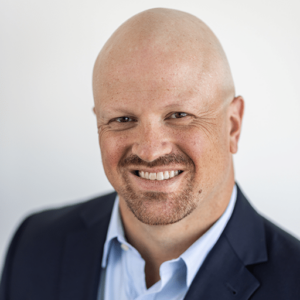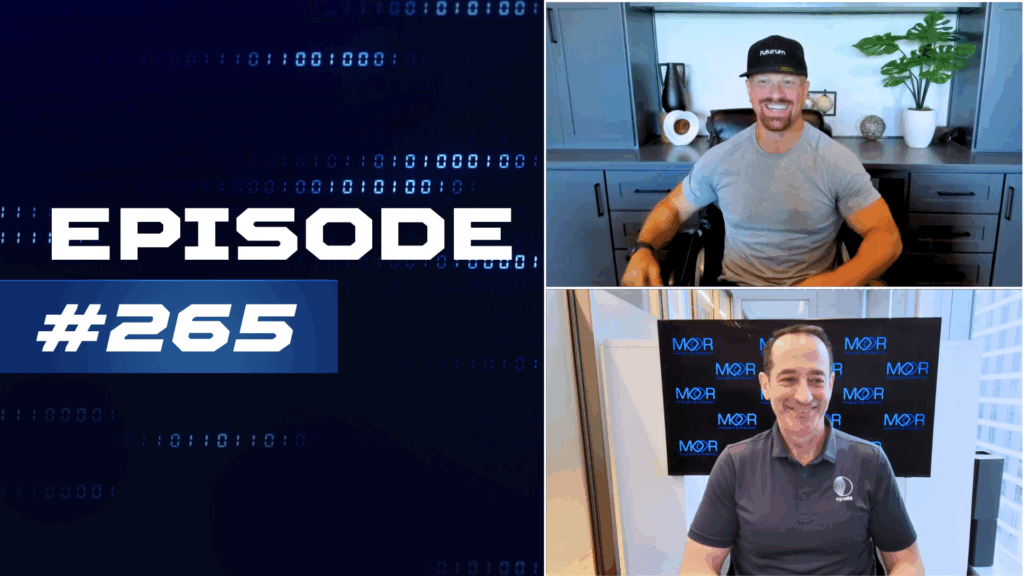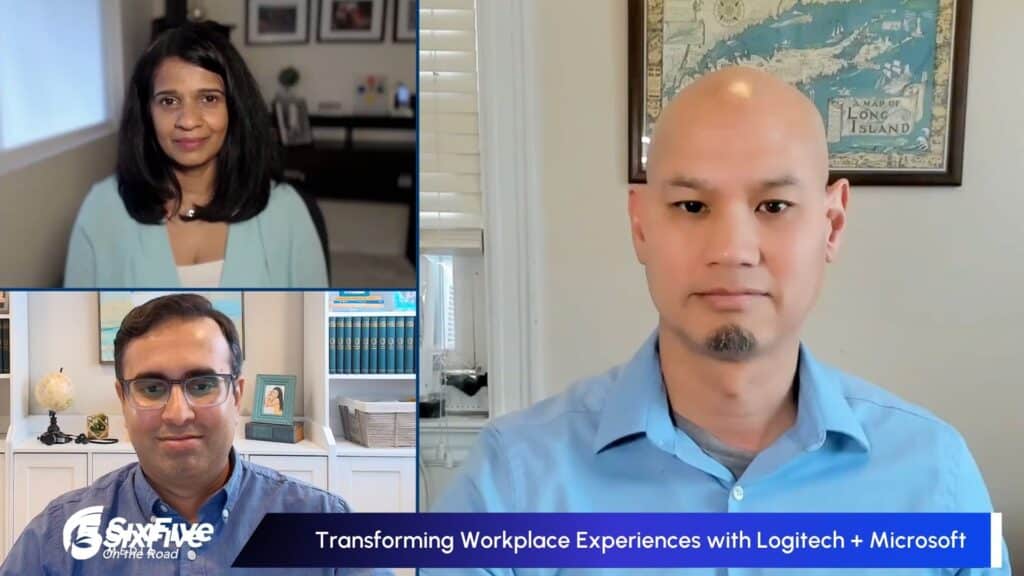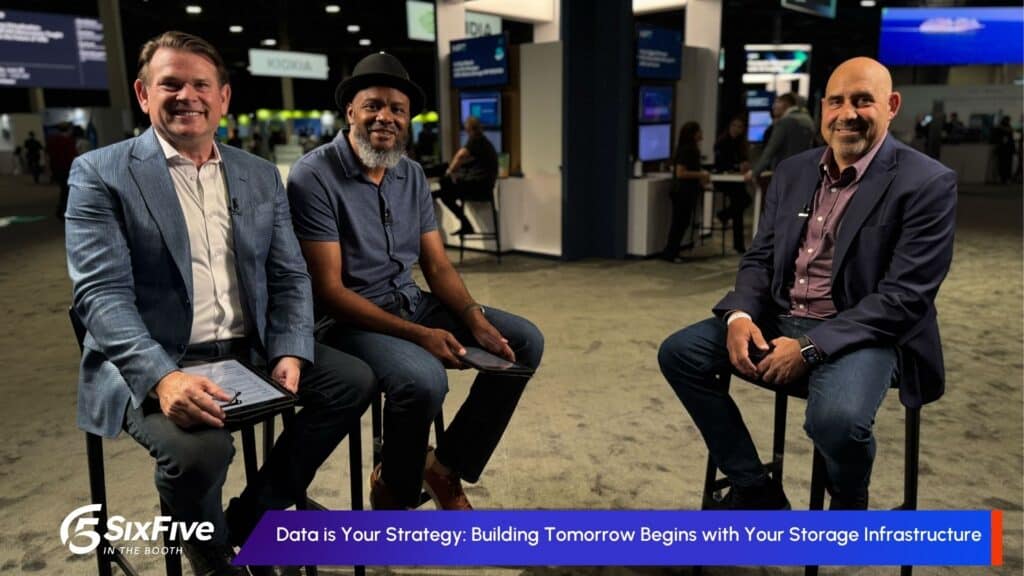On this episode of The Six Five – On The Road, hosts Daniel Newman and Patrick Moorhead welcome Varun Bijlani, Global Managing Partner, Hybrid Cloud Services Consulting at IBM and Jeff Calusinski, Senior Vice President and Chief Technology Officer at USAA for a conversation on the value of a Hybrid-by-Design cloud strategy for modernization.
Their discussion covers:
- A look at IBM Consulting’s Hybrid Cloud Services and how they can assist clients in defining and executing their technology and cloud strategies
- The strategic partnership between IBM Consulting and AWS for the AWS GenAI solution
- USAA’s GenAI journey and their partnership with AWS, IBM, and Red Hat for modernization services
- IBM’s Hybrid-by-Design framework, how it can benefit clients like USAA, and how to get started
Learn more about IBM’s hybrid cloud solutions on the company’s website.
Be sure to subscribe to The Six Five Webcast, so you never miss an episode.
Watch the video here:
Or Listen to the full audio here:
Disclaimer: The Six Five webcast is for information and entertainment purposes only. Over the course of this webcast, we may talk about companies that are publicly traded, and we may even reference that fact and their equity share price, but please do not take anything that we say as a recommendation about what you should do with your investment dollars. We are not investment advisors, and we ask that you do not treat us as such.
Transcript:
Patrick Moorhead: The Six Five is on the road at AWS re:Invent 2023 in Las Vegas. We are in a IBM’s client suite and we are talking to IBM executives and IBM customers. And Daniel, don’t you love … What do we call it? The purification when we have vendor analyst and end user out there to get maybe the real deal. I hate to say the real deal, but as analysts, we simplify things for those who haven’t been operators. And then you know the vendors are going to give the best look, right? But in the end, it’s about the clients utilizing the technology for the better good of their companies.
Daniel Newman: Listen, there’s two purification moments in the world of big tech, earnings day, for publicly traded companies, and what the customers have to say. The customers are the ground truth. And so as analysts, we’re often asked, what do we think? And our data, our calculus, as we like to say … By the way, haven’t done any calculus since college, just being honest.
Patrick Moorhead: Do they still teach that in college, in schools?
Daniel Newman: But the calculus that we do tends to be a combination of factors that tend to be driven in A, is the business growing? Does the market like the solutions? And B, are the customers validating that the market likes the solutions? So I always enjoy coming here to AWS re:Invent and these partner conversations that we’ve had with IBM, which has been a star in the AWS community. And then of course them bringing their customers to talk about what it really means has been a great way for us to get good insights to the market, coupled with, of course, our analysis.
Patrick Moorhead: That’s right. And what are some of the two biggest topics? First of all, when IBM laid it out, new CEO, it was going to be all about the hybrid cloud and all about AI. You and I have talked a lot about IBM’s capabilities and their competitors’ capabilities in AI, but I have to tell you, I love talking hybrid cloud. I love talking the hybrid multi-cloud. So literally, let’s dive in here. So I’d like to introduce Varun and Jeff from USAA. Varun from IBM. Great to have you on The Six Five.
Jeff Calusinski: Noted.
Varun Bijlani: Thank you.
Jeff Calusinski: Good to see you. Yeah, thanks for having us.
Patrick Moorhead: I feel like we’re doing an HBO special or something here, coffee talk type of thing. But no, this is a really good environment. So thank you, Varun, for letting us into your show here. Show within a show.
Varun Bijlani: Welcome out here. And I think having clients like Jeff with us is your truly defined purification moment, right? The truth comes out.
Daniel Newman: Yeah. So let’s tie a few threads together here. We’re at AWS. We’re in the IBM suite and we’re talking to USAA and IBM. So just a quick kind of specs. Varun, we’ll start with you. Role at IBM, your tie obviously here to AWS, and maybe just a little background on what you’re doing this week at re:Invent.
Varun Bijlani: Wonderful. Wonderful. So I have the privilege of running what is called our cloud services business globally at IBM Consulting. Now, in that context, the team and I, we work with partners like AWS, SAP and others to help clients like Jeff and others define or refine their cloud strategies and then implement those cloud strategies to really realize business value. And in that entire journey, our ecosystem partnerships plays a very, very important role. And therefore being here today, where we are a premier, one of the largest premier partners of AWS, is very, very important for us.
Patrick Moorhead: So Jeff, maybe you can talk about this triangle as well between USAA, IBM, and AWS. What are you all doing together?
Jeff Calusinski: Yeah, so USAA, and many might not realize, but we’re actually a digital company. We don’t have a brick and mortar. So digital capabilities, and by the way, we have to be on 24/7 because our members are military members and their families. So it’s worldwide. And so what we needed to have is the best in class ability to deliver hybrid cloud capabilities. And we chose AWS as a means to do that. We’ve been on a journey for about five years enabling that. And IBM has really helped us as we are leaning in to diversify our ability of hybrid cloud. We’ve made significant investments in things like OpenShift as a containerized platform and extending that into the cloud environments. So it’s really important for us to be able to take advantage of that because agility and time to market really matter for us.
Patrick Moorhead: Are there still building blocks that go into that, like IBM Center of Excellence, IBM Consulting services, and what are the building blocks of this?
Jeff Calusinski: Yeah, I mean, for us, it was … so we had to start … Because we’re highly regulated. So we’re a bank, we’re an insurance company, life insurance. And so we started with what we call a unified cloud risk framework. And this allowed us to understand the risks associated with workloads. And then taking and working with, say, IBM to then build out capabilities that are hybrid in nature, that are consistent with that foundation, were really important. We call it safe landing. And IBM’s really helping us safe land some new capabilities in the environment.
Daniel Newman: So Varun, I want to talk about the joint session that you did on Hybrid by Design. I’m going to come back to that though for a minute. Because I appreciated your opening answer but Pat and I have had a few conversations here with AWS folks. We talked to a marketplace team. They were raving about IBM and the advancements that the company and the partnership with AWS … how far you’ve come. And I think we both took note. We were like, wow. I mean, last year I think we had some meeting with a number of your leaders. Clearly the focus had changed. IBM and AWS all in. But can you just give us a little bit on the evolution of the partnership over the last year and then we’ll come back and talk a little about your session?
Varun Bijlani: Sure. So the whole relationship, when you look at our strategy, hybrid cloud and AI, at the core of that strategy is working with the ecosystem. And then you look at AWS as a critical player of that ecosystem. So we’ve made some really big investments in our relationship with AWS. More than 23,000 certifications. So today, my entire team, as a core capability, needs to be certified. Along with that, our acquisition strategy. Are we building expertise? Are we building capacity? And we are buying companies around the world that actually strengthen and enhance this commitment. And also, building solutions that can then be available on the AWS marketplace. So when you tie all of this up, that’s why AWS recognizes us as being one of the largest and fastest growing premier partners. I think that’s the power of that relationship. And when you bring those two together, the provider capability, our consulting services, then we are able to provide a more connected solution for clients like Jeff.
Patrick Moorhead: Yeah, so much of a more of mature look. And I like to joke that the cloud is a 14-year-old teenager and it’s not fully formed. Brain is not fully formed. But better situation than it was when the cloud was five years old or even 10 years old. And I think what I view is a mutual accountability and responsibility, whether you’re a public cloud player, you’re a combination on-prem … cloud and on-prem player to do what’s best for the customer. Right? And I view that as a maturation, and dare I say it, I’m viewing IBM as a new company with this new look and with this focus and some of your spinoffs and some of your acquisitions. It looks to us analysts like it’s a very different company. And I view conversations like this and arrangements like this as really, again, it sounds trite, but it is the new IBM and you spent a lot of years at IBM. And maybe it looks different to you, maybe it doesn’t, but as an analyst, and actually I was your competitor 35 years ago as well. It looks like a new company to me. So that’s editorial. Just thought I’d bounce that against you guys.
Daniel Newman: So heading back to the session we attended, the Hybrid by Design, Varun, I’d love for you to weigh in and then maybe Jeff a little bit too, but why is that so important? I mean, I guess it sounds like, of course, by design. I mean, why wouldn’t it be? But I think the fact is that it hasn’t been the easiest thing for most companies to figure it out. It hasn’t been immediate. We’ve talked about it a lot, but there’s a lot of growth and opportunity to get hybrid right and it seems that that’s where you are.
Varun Bijlani: Oh, absolutely. And I think every large enterprise today is hybrid by default. But it is only what we call business cloud masters who make intentional choices, which is around Hybrid by Design. So a lot of companies started with the standard lift and shift but struggled with realizing value. Only one in three programs are actually on time, on budget. One in four are actually realizing real ROI on their investments. And why? So when you start looking at a pattern of those kind of companies, have they really connected the business and IT blueprint? Have they anchored their technology choices based on what’s that business product and service that they want to get out for their customers and their employees? And that’s all about what consistency points are you as a company making on this journey? And that’s why we say making those intentional choices is all about Hybrid by Design. And it’s not just hybrid in terms of your on-prem environment and a public cloud environment like AWS. One of the biggest challenges is also the business and IT relationship. So it’s seamless hybrid there too.
Patrick Moorhead: Yeah. By the way, I’ve heard hybrid by accident. Some people say cloud by accident. But yeah, it was crazy about 10 years ago. Some of the board dictates that said, okay, we’re not buying anything on-prem. It’s all going to the public cloud. And then even today, I mean, 75% of the data is still on-prem. 90% of the spend is still on-prem. And I think that lift and shift timing, which was essentially, hey, how do I trade an inefficient layer? And maybe they’re monolithic applications, maybe they’re virtualized, just moving them over, or quite frankly, somebody else to make 20 to 30 points on that. It was like, wait a second, my costs are spiraling out of control. And I didn’t change anything in dev, OpSec, any of this. And therefore, those benefits of speed and agility weren’t … The scale was amazing if you needed it. But yeah, again, we’re in the maturing version of this cloud conversation. So Jeff, I think we’ve gone, gosh, 15 minutes and we haven’t talked about AI yet. And it feels like a lot of the analyst conversation, which by the way, many times is separated from the reality in terms of people doing it versus people talking about it. But I’m curious, where are you in your generative AI journey right now? And all the boards are dictating this and we want this. Reminds me of the we’re going all cloud baby about 10 years ago.
Jeff Calusinski: Well, here’s what I would say. We have gen AI as a function of our digital automation strategy. So gen AI by itself, though interesting, if you don’t have automated processes and a way to integrate, its consumability is limited.
Patrick Moorhead: Yeah, we talked about this in the green room, didn’t we? That you might’ve gotten a jump on this even before generative AI with your automation.
Jeff Calusinski: So for us, digital automation has been this continuum over time and there’s different levels of maturation across that continuum. And so while we’ve had AI for many years, we’ve done really innovative things from remote check capture, deposit capture and fire hazard types of things. But the way we’re looking at it is we’re experimenting to understand how this then leans into the rest of the automation strategy. And we’re a digital company, so automation is a big part of what we have to do because we don’t have brick and mortar. So if we don’t digitize things, we’re not going to get the efficiency and scale that is really required.
Patrick Moorhead: And on that automation, does that, dare I say, use a different term. I look at the world in terms of IaaS, PaaS and SaaS. Even if it’s on-prem I mean, is this all through that stack, this automation?
Jeff Calusinski: Yeah. So what you’ll see are things like … We’ll start with BPM is this traditional workflow types of automation to robotic process automation, which is … or low-code, no code. Then you look at your traditional AI models. Classic AI, if we want to call it that. Then we go into generative AI. And so across those continuum, you’re going to have these different levels of maturation and it, very much like our cloud strategy, it’s fit for purpose. We’re going to choose the right technology for the right problem versus force fitting one technology in for everything.
Patrick Moorhead: And is there a prioritization schema that you have? And is the basic ROI, is it … Sometimes we all have to show the board really cool tricks. Is it head count optimization?
Jeff Calusinski: Listen, this is about augmenting what people are doing today. So it’s amplifying, getting the efficiencies. So as we grow, we’ll be able to grow at a better rate, a more affordable rate, then in the absence of the technology. That’s the way that we’re looking at it. We feel that the best way to support our members is to leverage the technology in support of that. And I think gen AI and AI will play a pretty big role over time.
Daniel Newman: We started off the conversation talking about claims, talking about ground truths, talking about those moments that we determined the success. And one of the things that, Varun, that you mentioned though, you started throwing out some claims about ROI. So you’re living it, you’re implementing it, you’re helping them implement it. But 3.3, ROI-
Patrick Moorhead: Plus. ROI plus.
Daniel Newman: 3.3 plus or times ROI. I always find those numbers to be really compelling and yet really hard for me to understand how they’re calculated. How are you guys arriving at that Hybrid by Design is yielding ROI? Is it on these projects? And what’s the way you’re coming to that conclusion? Because you would think that you’d be spending a lot more, or maybe even more would be the right word, if you can continue to get that out-sized return.
Varun Bijlani: So I think you’ve got to break down in how we articulate that value. So when you start looking at what are those core contributors to value and then where are you getting the exponential contribution? The core contributions come from things like infrastructure cost optimization or developer productivity, savings in security and compliance. And then that starts releasing a couple of other areas, like what sort of strategic optionality does it now offer me? And when you start putting those together, you start seeing the ability to reach a larger customer base, to reach a customer base quicker, to drive adoption and increase adoption and therefore increased revenues. And you start seeing the business becoming more agile because of IT velocity and workforce productivity. Now when you start adding all these things up, you start realizing that it’s 3X or 3.3X if you want to put mathematics to it around from what you would’ve typically done in what we would call a hybrid. By default. I’ve got all these places, I’ve got cloud sprawl. But if I’m intentional, I’m actually impacting these levers. And you can measure each one separately.
Patrick Moorhead: Right.
Daniel Newman: Yeah.
Patrick Moorhead: I think that’s great. Listen, I’m a fan of hybrid multi-cloud. I was pretty outspoken about 10 years ago when my company was getting behind it. Now, I backed the wrong horse with OpenStack, okay? And the world ended up being containers but everybody … I think the entire industry gave that a shot. So we heard about the 3.3 RX, 3.3X plus ROI improvement. How do you express the benefits of a hybrid multi-cloud strategy? What are the benefits that you’re seeing?
Jeff Calusinski: Yeah, so one of the things that we are seeing manifest itself. So the way … We didn’t do a lift and shift, and so for us, we were looking at either you retire, you rewrite, or you refactor. And so as a part of our modernization journey, we’ve been refactoring our applications to be more agile and nimble. But we also retired a bunch of applications. So by shifting to leveraging software as a service and cloud capabilities managed services from cloud providers, we got rid of technical debt. Technical debt, for us, we have multiple versions of the same thing. Consolidating to a single platform really allowed us to be more efficient and effective. And the transition costs then allowed us to do that more effectively. And so for us, that’s a big part of it. But as a digital company, one that’s growing, we have to say, okay, how do we expand as quick as possible? When the opportunity presents itself, how do we achieve those business outcomes that we’re trying to achieve? And so that, to us, is really, really important. Those moments that matter are critical for us.
Patrick Moorhead: Just to follow up on that, when you say refactor, is this going from monolithic to containers, monolithic to virtualized applications? What does that look like?
Jeff Calusinski: Yeah. For us, I think we’re very similar to a lot of other companies that had the three layered architecture. Transitioning that and refactoring to us means decomposing and creating more layers within the architecture and containerizing the workload. This is not about taking a WebSphere app and putting it in JBoss. This is about moving things to OpenShift or Spring Boot, running them in liberty or whatever.
Patrick Moorhead: Great answer.
Jeff Calusinski: Right? Yeah, exactly. I hope so because that’s the design point.
Patrick Moorhead: No. I mean, that’s what I think of modernized, but that’s not the answer I always get. In fact, I had a conversation yesterday about modernizing was putting a monolithic into virtualization. I’m like, okay, it’s a step, but the step we first started taking about 12 years ago.
Jeff Calusinski: But it takes a significant investment to make that commitment. But you have to realize for the long game how that positions you for an agility standpoint.
Patrick Moorhead: Well, the options it gives you. I mean, you want to run it here, you want to run on the edge, you want to run it in your own data center-
Jeff Calusinski: Yeah. That’s right.
Patrick Moorhead: -you want to run it in any multi-cloud that you want, your sovereign cloud. You buy a company and they have … So anyways, I’m a big fan.
Daniel Newman: Yeah, you’ve got to be able to move quickly and that’s what you’re setting up to do. Speaking of moving quickly, Varun, as we wrap up here. And by the way, thank you both so much for your insights. You didn’t fall for Pat’s trick question. He wanted to see if you said virtualize it.
Patrick Moorhead: It happened yesterday.
Daniel Newman: Yeah, yeah, yeah. So anyways, how do you get people and companies, like Jeff and USAA, going? Because this Hybrid by Design thing takes effort. So what’s the IBM approach that you do to get customers on the track and accelerate this Hybrid by Design?
Varun Bijlani: I think, in truth, almost every company today already has some form of a cloud strategy. So I’m clear about when we are helping them, it’s about refining that strategy. It’s about being able to anchor on what are those specific business products and services that are going to drive value for you? And for those, how do you steer your technology architecture? And we go through this value framework called the Hybrid by Design value framework, which then starts taking you on linking ROI to the IT blueprint to whether you refactor, you retire, or you rewrite new capabilities. So that entire journey, it’s a short strategy phase, the outcome of which is a business case along with a defined roadmap with the first few value runs. And then you iterate on that.
Daniel Newman: Varun, Jeff, I want to thank you both so much for taking a little time out here at AWS re:Invent to talk about what you’re doing with hybrid cloud. Jeff, to share the ground truth of how USAA is modernizing and taking a Hybrid by Design approach. And hopefully we’ll have you both back on sometime soon.
Jeff Calusinski: Thanks. Appreciate it.
Varun Bijlani: Wonderful. Thank you.
Daniel Newman: All right everybody, hit that subscribe button. Join us for all of the episodes of The Six Five On the Road here at AWS re:Invent 2023 and of course all the episodes here on The Six Five. For Patrick Moorhead and myself, we’ve got to say goodbye for now. We’ll see you all soon.
Author Information
Daniel is the CEO of The Futurum Group. Living his life at the intersection of people and technology, Daniel works with the world’s largest technology brands exploring Digital Transformation and how it is influencing the enterprise.
From the leading edge of AI to global technology policy, Daniel makes the connections between business, people and tech that are required for companies to benefit most from their technology investments. Daniel is a top 5 globally ranked industry analyst and his ideas are regularly cited or shared in television appearances by CNBC, Bloomberg, Wall Street Journal and hundreds of other sites around the world.
A 7x Best-Selling Author including his most recent book “Human/Machine.” Daniel is also a Forbes and MarketWatch (Dow Jones) contributor.
An MBA and Former Graduate Adjunct Faculty, Daniel is an Austin Texas transplant after 40 years in Chicago. His speaking takes him around the world each year as he shares his vision of the role technology will play in our future.










